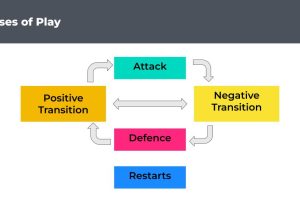Challenges in Implementing a New Soccer Game Model: A Comprehensive Analysis
Implementing a new soccer game model can be a daunting task for any coach or team. A game model is a tactical framework that defines how a team plays the game of soccer. It provides a guideline for the team’s style of play, principles of play, and tactical approach. The game model should reflect the coach’s philosophy and the team’s strengths and weaknesses.
Understanding soccer game models and the key elements of a soccer game model is crucial before implementing a new model. A game model is not just a formation or a style of play. It includes the team’s strategy and tactics, such as how to build a play and finish it. The game model should be based on the team’s strengths and weaknesses, and it should be flexible enough to adapt to different opponents and situations.
Despite the benefits of having a game model, implementing a new soccer game model can be challenging. It requires a lot of time, effort, and resources to develop and implement a new model. Coaches and players may need to change their mindset and adapt to a new style of play. Moreover, the success of a new game model may not be immediate, and coaches may need to be patient and persistent in the implementation process.
Key Takeaways
- Understanding soccer game models and the key elements of a soccer game model is crucial before implementing a new model.
- Implementing a new soccer game model can be challenging and requires a lot of time, effort, and resources.
- The success of a new game model may not be immediate, and coaches may need to be patient and persistent in the implementation process.
Understanding Soccer Game Models
Definition and Importance
A soccer game model is a strategic framework developed by coaches to enhance their team’s performance during specific sub-phases of play. It is a tactical approach adopted by coaches to improve player functionality and performance on the field. A game model defines how a team plays, and it is based on the coach’s conception of soccer.
The importance of a soccer game model lies in its ability to give direction to the team and provide a common understanding of how they should play. It helps to create predictability through preparation, planning, and training. A game model helps coaches to identify the strengths and weaknesses of their players, and it also enables them to develop a playing style that suits the team’s abilities.
Different Types of Game Models
There are different types of game models that coaches can adopt based on their team’s strengths, weaknesses, and playing style. The following are some of the most popular game models used in soccer (granted, game models are far more complex than this – but you get the idea):
- Possession-based game model: This game model focuses on maintaining possession of the ball and dominating the game through short passes. The aim is to control the game and create scoring opportunities through patient build-up play.
- Counter-attacking game model: This game model is based on quick transitions from defense to attack, with a focus on exploiting the opposition’s weaknesses. The aim is to hit the opposition with fast, direct attacks and score goals on the break.
- Pressing game model: This game model is based on high-intensity pressing to win the ball back quickly and disrupt the opposition’s play. The aim is to force the opposition into making mistakes and create scoring opportunities through turnovers in possession.
- Direct game model: This game model is based on long balls and aerial duels, with a focus on playing the ball forward quickly and bypassing the opposition’s midfield. The aim is to create scoring opportunities through direct play and capitalize on the opposition’s defensive weaknesses.
In conclusion, understanding soccer game models is crucial for coaches who want to improve their team’s performance on the field. A game model provides a clear direction for the team and helps to create predictability through preparation, planning, and training. There are different types of game models that coaches can adopt based on their team’s strengths, weaknesses, and playing style.
Key Elements of a Soccer Game Model
A soccer game model is a tactical and strategic approach developed by coaches to enhance the team’s performance in specific sub-phases of play. It is a framework that guides the team’s style of play, principles of play, and roles and responsibilities of players. A well-designed game model can help a team achieve its goals and objectives.
Formation and Style of Play
The formation and style of play are essential elements of a soccer game model. The formation refers to the arrangement of players on the field and can vary depending on the team’s strengths, weaknesses, and tactical approach. The style of play refers to the team’s overall approach to the game, including its attacking and defensive strategies, possession style, and tempo.
Coaches must consider the team’s strengths and weaknesses when selecting a formation and style of play. For example, a team with strong attacking players may opt for an offensive formation, while a team with a solid defense may prefer a more defensive approach.
Principles of Play
The principles of play are fundamental concepts that guide a team’s approach to the game. They include concepts such as attacking, defending, possession, and transition. Coaches must ensure that all players understand and can execute the principles of play effectively.
For example, a team that values possession may prioritize keeping the ball and building up play patiently, while a team that values attacking may focus on quick transitions and counter-attacking.
Roles and Responsibilities of Players
The roles and responsibilities of players are crucial to the success of a soccer game model. Each player must understand their position and responsibilities within the team’s formation and style of play. Coaches must ensure that each player is playing to their strengths and contributing to the team’s overall strategy.
For example, a team that values possession may require its midfielders to be comfortable on the ball and able to distribute it effectively, while a team that values attacking may require its forwards to be quick and decisive in front of goal.
In summary, the key elements of a soccer game model include the formation and style of play, principles of play, and roles and responsibilities of players. Coaches must develop a game model that is tailored to the team’s strengths and weaknesses and can effectively guide the team to achieve its goals and objectives.
Implementing a New Soccer Game Model
Implementing a new soccer game model can be a challenging process that requires careful planning, preparation, and execution. In order to successfully implement a new game model, coaches and managers must take into account a range of factors, including training, communication, adaptation, and feedback.
Planning and Preparation
The first step in implementing a new soccer game model is to carefully plan and prepare for the changes that will be required. This may involve conducting a thorough analysis of the current team’s strengths and weaknesses, as well as identifying areas where improvements can be made.
Coaching staff and managers should work together to create a detailed plan for implementing the new game model, including timelines, milestones, and key performance indicators. This plan should be communicated clearly to all members of the team, so that everyone is aware of what is expected of them.
Training and Adaptation
Once the plan has been developed, the next step is to begin training the team to adapt to the new game model. This may involve a range of activities, including drills, scrimmages, and full-scale practices.
Coaching staff should work closely with players to ensure that they understand the new game model and are able to adapt their playing style accordingly. This may involve making adjustments to individual roles and responsibilities, as well as developing new strategies and tactics.
Communication and Feedback
Effective communication and feedback are essential to the success of any new soccer game model. Coaching staff and managers should maintain open lines of communication with players, providing regular updates on progress and addressing any concerns or questions that arise.
At the same time, players should be encouraged to provide feedback on the new game model, including what is working well and what could be improved. This feedback can be used to make adjustments to the game model over time, ensuring that it continues to meet the needs of the team.
Overall, implementing a new soccer game model requires careful planning, preparation, and execution. By focusing on training, adaptation, communication, and feedback, coaching staff and managers can help ensure that the team is able to successfully adopt the new game model and achieve its goals.
Challenges in Implementing a New Soccer Game Model
Implementing a new soccer game model can be a challenging task for coaches. There are several factors that can make it difficult to successfully implement a new game model. In this section, we will discuss some of the most common challenges that coaches face when trying to implement a new soccer game model.
Resistance to Change
One of the biggest challenges that coaches face when trying to implement a new soccer game model is resistance to change. Players may be resistant to change because they are used to playing a certain way and may not want to change their style of play. Coaches may also be resistant to change because they are comfortable with their current coaching methods and may not want to try something new.
To overcome resistance to change, coaches must communicate the benefits of the new game model to their players. They should explain how the new game model will help the team to be more successful and how it will benefit individual players. Coaches may also need to provide additional training and support to help players adjust to the new game model.
Physical and Technical Demands
Implementing a new soccer game model may require players to adapt to new physical and technical demands. For example, a new game model may require players to run more, be more aggressive, or use different techniques. These changes can be difficult for players who are not used to them.
To overcome physical and technical demands, coaches must provide appropriate training and support to help players adapt to the new game model. This may include additional fitness training, technical training, and tactical training. Coaches may also need to adjust their coaching methods to help players develop the skills they need to succeed in the new game model.
Time and Resource Constraints
Implementing a new soccer game model can be time-consuming and may require additional resources. Coaches may need to spend more time planning and preparing for training sessions and games. They may also need to invest in new equipment or hire additional staff to help with training and support.
To overcome time and resource constraints, coaches must be organized and efficient in their planning and preparation. They should prioritize their time and resources to focus on the most important aspects of implementing the new game model. Coaches may also need to work with their club or organization to secure additional resources, such as funding or equipment, to support the implementation of the new game model.
In conclusion, implementing a new soccer game model can be a challenging task for coaches. However, by addressing resistance to change, physical and technical demands, and time and resource constraints, coaches can successfully implement a new game model and help their team to be more successful on the field.
Technological Role in Soccer Game Models
Soccer is a constantly evolving sport, and technological advancements have played a significant role in shaping the game. In recent years, the use of technology in soccer has become more prevalent, and it has influenced the way teams play and train. This section will explore the technological role in soccer game models.
Sports Analytics
Sports analytics is the process of collecting and analyzing data to gain insights into player performance and team strategies. In soccer, sports analytics can be used to track player movement, passing accuracy, and other key performance indicators. This data can then be used to optimize team strategies and player development.
Big data is a crucial component of sports analytics, as it allows teams to collect and store vast amounts of data. This data can be analyzed using machine learning algorithms to identify patterns and trends. For example, a team may use machine learning to identify the most effective passing patterns or to predict the likelihood of a particular player scoring a goal.
Artificial Intelligence and Machine Learning
Artificial intelligence (AI) and machine learning (ML) have become increasingly important in soccer game models. AI and ML can be used to analyze vast amounts of data and identify patterns that would be difficult for humans to detect. For example, a neural network can be trained to identify the most effective passing patterns based on historical data.
Deep learning is a subset of machine learning that involves training neural networks with large amounts of data. In soccer, deep learning can be used to analyze player movement and identify patterns that can be used to optimize team strategies. For example, a deep learning algorithm may be used to identify the most effective defensive formations based on historical data.
In conclusion, technological advancements have played a significant role in shaping soccer game models. Sports analytics, AI, and ML have all contributed to the optimization of team strategies and player development. As technology continues to evolve, it is likely that it will continue to play an increasingly important role in soccer.
Case Study: FC Barcelona’s Tiki-Taka
FC Barcelona’s Tiki-Taka is a football game model that has revolutionized the way the game is played. It is a style of play that emphasizes short passes, quick movement, and ball possession. The model has been so successful that it has become a benchmark for many football teams around the world.
The Tiki-Taka model was first introduced by Pep Guardiola, the former FC Barcelona coach, during his tenure from 2008 to 2012. The model was based on the principles of Total Football, which emphasizes that every player on the field should be able to play in any position. The Tiki-Taka model has been so successful that it has won many accolades, including the UEFA Champions League, La Liga, and the FIFA Club World Cup.
The Tiki-Taka model has been so successful that it has become a benchmark for many football teams around the world. However, implementing this model is not easy, and many teams have struggled to replicate the success of FC Barcelona. One of the reasons for this is that the model requires a lot of technical ability and discipline from the players. It also requires a lot of practice and patience to perfect.
The English Premier League is one of the leagues that have struggled to implement the Tiki-Taka model. The league is known for its physicality and fast-paced football, which is very different from the Tiki-Taka model. Many teams have tried to implement the model, but they have struggled to adapt to the new style of play.
In conclusion, FC Barcelona’s Tiki-Taka model has revolutionized the way football is played. The model has been so successful that it has become a benchmark for many football teams around the world. However, implementing the model is not easy, and many teams have struggled to replicate the success of FC Barcelona. The English Premier League is one of the leagues that have struggled to implement the Tiki-Taka model due to its physicality and fast-paced football.
Evaluating the Success of a Soccer Game Model
Implementing a new soccer game model can be a challenging task for coaches and players alike. However, evaluating the success of a new game model is equally important to ensure that the team is on the right track. In this section, we will discuss how to evaluate the success of a soccer game model.
Performance Analysis
One of the most critical aspects of evaluating the success of a soccer game model is performance analysis. Coaches must analyze the team’s performance in different sub-phases of play to identify areas of strength and weakness. This analysis can be done through video analysis or statistical analysis.
Video analysis involves reviewing match footage to identify patterns of play, player movements, and decision-making. Statistical analysis involves analyzing data on metrics such as possession, shots on target, and passing accuracy. Both methods can provide valuable insights into the team’s performance and help coaches make informed decisions.
Identifying Areas for Improvement
Once coaches have analyzed the team’s performance, they can identify areas for improvement. These areas can include performance problems such as poor passing accuracy, lack of creativity in attack, or poor defensive organization. Coaches can then develop training sessions that focus on improving these areas.
To ensure that the team is making progress, coaches can set performance targets for each area of improvement. For example, if the team is struggling with passing accuracy, the coach can set a target of completing a certain percentage of passes in the next match. This approach will help the team focus on specific areas of improvement and track their progress over time.
In conclusion, evaluating the success of a soccer game model is crucial to ensure that the team is on the right track. Coaches must analyze the team’s performance in different sub-phases of play and identify areas for improvement. By setting performance targets and tracking progress over time, coaches can ensure that the team is making progress and achieving success.
Frequently Asked Questions
What are some common challenges faced when implementing a new soccer game model?
Implementing a new soccer game model can be challenging for coaches and players alike. Some common challenges include resistance to change, lack of understanding of the new model, and difficulty in adapting to new tactics and strategies. Additionally, players may struggle with the physical demands of the new model and may require additional training to improve their fitness levels.
What are the key elements to consider when developing a soccer game model?
When developing a soccer game model, coaches should consider several key elements, including the team’s strengths and weaknesses, the opponent’s playing style, and the specific goals and objectives of the team. Coaches should also consider the team’s formation, player positions, and tactical strategies to ensure that the game model is effective.
What are the benefits of using a tactical periodization approach in youth soccer?
Tactical periodization is an approach to training that focuses on developing players’ technical, tactical, and physical abilities through a systematic and progressive training program. This approach can be particularly effective in youth soccer, as it helps players to develop a strong foundation of skills and knowledge that they can build upon as they progress through their careers.
How can coaches effectively train a new soccer team to implement a new game model?
Coaches can effectively train a new soccer team to implement a new game model by focusing on clear communication, consistent training, and a gradual progression of tactics and strategies. Coaches should also provide players with individual feedback and support to help them understand and adapt to the new model.
What are some best practices for developing a player development plan in soccer?
When developing a player development plan in soccer, coaches should focus on individualized training, goal-setting, and regular feedback. Coaches should also provide players with opportunities to develop their skills through game-like situations and should encourage players to take ownership of their own development.
What are the differences between the U.S. soccer style of play and other soccer styles?
The U.S. soccer style of play is often characterized by a focus on athleticism, physicality, and direct play. In contrast, other soccer styles, such as the possession-based style used by teams like Barcelona, emphasize technical ability, ball control, and patient buildup play. Coaches should consider these differences when developing a game model and should tailor their approach to the strengths and weaknesses of their team.







